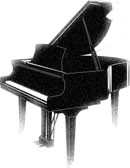Piano scales – overviews and instructions
 Piano scales are valuable knowledge for every person playing the piano. It is the theory of note relationship that will help you understand chords and other concepts in music. Playing scales is a great way for improving your technique and they can serve as building blocks for creating melodies.
Piano scales are valuable knowledge for every person playing the piano. It is the theory of note relationship that will help you understand chords and other concepts in music. Playing scales is a great way for improving your technique and they can serve as building blocks for creating melodies.
Because of the relationship between notes in specific scales, they will always sound well played together and have their own characteristics. This makes scales a primary foundation for anyone who wants to improvise on the instrument. It can be done just by playing the white keys as in the C Major Scale, or it can be more advanced by, for example, using modus for jazz improvisation. Therefore, you shouldn't consider scales as boring and dull – it can be your step to a new level of playing. In addition, training at scales will make your fingers stronger. This, in combination with your increasing knowledge about how the tones relate, will make you capable to playing faster.
On this site you can learn lots of piano scales and receive tips explaining how to use them. It is boring just to memorize if you don't understand the use of it … Therefore, the idea is to always provide the musical context for the scale and not just hand over the notes.
In the menu, you will find different categories of piano scales as well as resources including printable scales and explanations of correct fingering. There are more areas to explore, including exercises and an introduction to the theory of piano scales. If needed, go to the Questions & answers.
 New scale with pictures and theory: Mixolydian Hexatonic Scale
New scale with pictures and theory: Mixolydian Hexatonic Scale
The Mixolydian Hexatonic is missing a third interval and thereby contains six notes.
 Learning tool: Reversed scale finder
Learning tool: Reversed scale finder
Select keys on the keyboard and the tool analyzes possible scales.
Become a member
Hopefully some of you piano learners will support the site and make it possible to create more quality-focused educational material.
As a member you get:
- Sheet music in different versions plus sound.
- Scales in musical notes (pdf).
- Graphic scale collections.
- Lessons and interactive ear training.
- Piano backing tracks.
- Access to new exclusive material that is produced.
- Being a very appreciated supporter of this site.
The exclusive material is accessible from your member page … More details
How to define scales
Scales are collections of notes that follow a specific pattern and are grouped together. They can also belong to a certain key. This relationship is also true about chords – but the difference between chords and scales is that a scale normally consists of more notes, which are not played simultaneously as often is the case with chords.
A scale consists of notes that have a musical connection and are building blocks for chords and schemes for improvisation. By knowing and recognizing scales, you will be able to place a song in a musical context and as a result be able to play it with less effort. Knowing scales on the piano can, of course, also assist you in composing your own music.
Attitudes toward scales
As mentioned above, this part of your piano education is sometimes given negative connotations: scales are intruding on your freedom of creativity and things like that. The truth is that scales aren't about strict rules, but more like a background in your practice. (As a footnote, atonal music can be mentioned here, that is a reaction against the tonal music).
Exactly which scales you should focus upon will depend on the musical styles that interest you. But generally, a good advice is to learn the Major Scale considering how common it is in piano music. Important to study is also the Minor Scale which exists in three different versions – the natural, the harmonic and the melodic. Don't worry, they are almost similar but the distinctions will give you new possibilities. The Pentatonic scales are also common, and in some styles the modal scales are frequently used.
The keyboard
The piano has 88 keys that are put together on a keyboard. As shown in the picture below the keyboard on a piano is symmetrical arranged in twelve – seven white and five black – keys that are repeated (some exceptions are shown in the left and right ends). These keys are also ordered in octaves that makes eight notes. Every interval between two notes of the same tone, as a C to a higher C, is an octave.
The notes
Playing piano is often done by reading notes. Below you can see an illustration of notes on a staff – here as the scale of D major.

On this site you can find exercises with scales written in notes.
Copyright
The pictures that illustrate the scales on this site are protected by copyright and are not allowed to be used or published without permission.